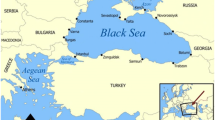Abstract
Gas chromatographic analyses of mussels, Mytilus galloprovincialis, from different areas of the Lagoon of Venice show that these organisms contain a very complex mixture of hydrocarbons attributable to fuel oil contamination. The measured amounts normally range from 0.8 to 8.7 mg/100 g wet weight, but values as high as 22.0 mg/100 g have been recorded. This high value indicates a saturation limit for these organisms which is considerably higher than those values normally found in mussels from the lagoon. The aliphatic hydrocarbon levels in mussels are related to distance from pollution sources and to the degree of exchange between the sea and the area sampled. On the basis of this relationship between overall hydrocarbon pollution load and level of contamination of M. galloprovincialis, it appears that this bivalve might be effectively utilized as a self-integrating monitoring index of oil pollution in the wasters of the lagoon.
Similar content being viewed by others
Literature Cited
Bedford, J. W., E. W. Roelofs and M. J. Zabik: The freshwater mussel as a biological monitor of pesticide concentrations in a lotic environment. Limnol. Oceanogr. 13, 118–126 (1968).
Blumer, M., R. R. L. Guillard and T. Chase: Hydrocarbons of marine phytoplankton. mar. Biol. 8, 183–189 (1971).
—, G. Souza and J. Sass: Hydrocarbon pollution of edible shellfish by an oil spill. Mar. Biol. 5, 195–202 (1970).
Cahnmann, H. J. and M. Kuratsune: Determination of polycyclic aromatic hydrocarbons in oysters collected in polluted water. Analyt. Chem. 29, 1312–1317 (1957).
Clark, R. C. and M. Blumer: Distribution of n-paraffins in marine organisms and sediment. Limnol. Oceanogr. 12, 79–87 (1967).
Connell, D. W.: Kerosene-like tainting in Australian mullet. Mar. Pollut. Bull. 2, 188–189 (1971).
Farrington, J. W. and J. G. Quinn: Petroleum hydrocarbons in Narragansett Bay. 1. Survey of hydrocarbons in sediments and clams (Mercenaria mercenaria). Estuar. cstl mar. Sci. 1, 71–79 (1973).
Ferri Cataldi, G.: Le industrie che inquinano Venezia. Inquinamento 12, 14–21 (1970).
Heros, M.: Dosage des hydrocarbures polycondensés, cancérigènes ou non, dans les milieux biologiques. In: Pollution des milieux vitaux par les hydrocarbures cancérigènes, pp 11–20. Ed. by L. Mallet. Paris: Librairie Maloine S.A. 1972.
McPherson, S. P., E. Sawicki and F. T. Fox: Characterization and estimation of n-alkanes in airborne particulates. J. Gas Chromat. 4, 156–159 (1966).
Metcalfe, L. D., A. A. Schmitz and J. R. Pelka: A rapid preparation of methyl esters. Analyt. Chem. 38, 514–515 (1966).
U.S. Department of the Interior: The effects of pesticides on fish and wildlife. Circ. Fish Wildl. Serv., Wash. 226, 1–77 (1965).
Youngblood, W. W., M. Blumer, R. L. Guillard and F. Fiore: Saturated and unsaturated hydrocarbons in marine benthic algae. Mar. Biol. 8, 190–201 (1971).
Author information
Authors and Affiliations
Additional information
Communicated by B. Battaglia, Padua
Rights and permissions
About this article
Cite this article
Fossato, V.U., Siviero, E. Oil pollution monitoring in the Lagoon of Venice using the mussel Mytilus galloprovincialis . Mar. Biol. 25, 1–6 (1974). https://doi.org/10.1007/BF00395101
Accepted:
Issue Date:
DOI: https://doi.org/10.1007/BF00395101




